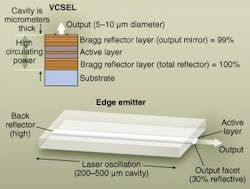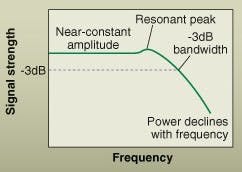PHOTONIC FRONTIERS: Cranking up the bandwidth: The quest for high-speed VCSELs

Vertical-cavity surface-emitting lasers (VCSELs) emitting at 850 nm cornered the market for short-haul optical data communications because of their low cost and ease of direct modulation at gigabit speeds. But the emergence of 10 Gigabit Ethernet (10 GigE) and the push for short links at 40 Gbit/s and above are creating a demand for higher-speed VCSELs.
Transmission at 10 GigE rates is possible, but developers still are trying to improve device lifetime and performance. Higher data rates pose a host of tough challenges. Data rates possible through short copper links continue to improve incrementally. "To be competitive optically, we want to do at least 20 Gbit/s" by simple direct modulation of the VCSEL, says Kevin Lear of Colorado State University (Fort Collins, CO). He thinks that 40 Gbit/s is attainable. Pushing to even higher speeds will require more-elaborate schemes, and progress is also being made on that front. Last year, Connie Chang-Hasnain's group at the University of California at Berkeley (Berkeley, CA) reported that optical injection-locking raised the resonance of VCSELs to 50 GHz, promising even higher modulation speeds.1
VCSEL characteristics and features
Vertical-cavity laser properties arise from their unique structure, which is different from an edge-emitting diode laser (see Fig. 1). Highly reflective mirrors are needed to sustain oscillation in the short VCSEL cavity; this produces high circulating power but relatively weak output beams. When operated in a single mode, VCSELs generate about an order of magnitude less power than single-mode edge emitters--which makes edge emitters the lasers of choice for long-distance transmission, but leaves an important role for VCSELs in short data links and in chip-to-chip connections.
Material considerations are important because VCSEL mirrors are Bragg reflectors made by depositing a series of thin semiconductor layers of two alternating compositions. Such stacks are easy to make in short-wavelength gallium arsenide (GaAs) materials because the refractive index varies strongly with composition. Indium phosphide (InP) compounds normally used for long-wavelength lasers are more difficult because the refractive index varies little with composition, so developers are looking at other compositions for VCSELs in the 1300 and 1550 nm windows.
Direct modulation is preferred for short high-speed links because -external modulators are expensive and have typical coupling losses of 3 to 6 dB, which can be ill afforded when using low-power VCSELs. Wavelength chirp has discouraged direct modulation of edge emitters because it multiplies the impact of chromatic dispersion in long lengths of fiber. Vertical-cavity lasers also suffer chirp, but it poses less of a problem because VCSELs normally are used only in short-range systems where the total chromatic dispersion is much smaller.
Several factors affect VCSEL modulation bandwidth. Modulation bandwidth generally increases with bias current until saturation phenomena become important, says Lear, adding that researchers have yet to quantify how gain saturation limits device speed. Concentrating power in a single mode by limiting the width of the emitting area to 5 to 10 µm also increases speed. Careful engineering can keep thermal problems and electrical parasitics from seriously impairing bandwidth.Bandwidth and system considerations
Bandwidth can be measured in three distinct ways. Two analog measurements involve the internal resonance of the -laser, and the higher frequency at which bandwidth has dropped by 3 dB below the uniform low-frequency response (see Fig. 2). Typically, the 3 dB bandwidth is about 20% above the resonant frequency. Digital response is measured as the maximum receivable bit rate for large signal modulation, which can exceed the 3 dB frequency. "You can get to a point where you're close to having two bits for each period of a sinusoid," Lear says; to reach a data rate of 40 Gbit/s he's shooting for a 3 dB frequency of 25 to 30 GHz.
Lear's group is focusing on short links for the Chip to Chip Optical Interconnect (C2OI) program run by the Defense Advanced Research Projects Agency (DARPA; Washington, D.C.). That program is focused on short wavelengths, particularly the now-standard 850 nm band of GaAs lasers, for links through free space, short lengths of multimode graded-index fiber, or on-chip waveguides. Gallium arsenide VCSELs are well developed at 850 nm, but InGaAs devices at 980 nm or longer offer higher differential gain. The difference between the wavelengths matters little for multimode fiber links, in which modal dispersion limits data rate and distance, but 850 nm is preferred for use with polymer waveguides on chips, which have significantly higher attenuation at 980 nm.
Longer links through single-mode fibers require longer-wavelength VCSELs. Directly modulated 1300 nm VCSELs are attractive for low-dispersion transmission through standard single fiber; longer wavelength VCSELs are sought for coarse wavelength-division multiplexing at longer wavelengths. In both cases, prime goals are to eliminate the costs and complexities of thermoelectric coolers and external modulators.
Simple direct modulation
Although VCSELs haven't yet matched the high speeds of the fastest directly modulated edge emitters, they have reached respectable speeds. The fastest so far have been 850 nm lasers, which have undergone the most commercial development. An early experiment a decade ago at Sandia National Laboratories demonstrated small-signal bandwidth of 21.5 GHz at 850 nm, although equipment limited the measured digital data rate to 12 Gbit/s.2
More recent efforts have focused on designing high-speed VCSELs that are long-lived and easier to produce. For example, Lear's group in 2004 used a simplified process to make 850 nm VCSELs with 3 dB bandwidth of 17.0 GHz that was not affected by external circuit effects.3 The Matsushita Semiconductor Device Research Center (Kyoto, Japan) has demonstrated 850 nm VCSELs with 16 GHz bandwidth with stable output for more than 1000 hours while operating at constant drive current at 100°C.4
Lifetimes of 850 nm VCSELs operated at high speeds have been problematic because of dislocations in the GaAs/-GaAlAs quantum wells used in their active layers, so developers are looking at alternatives emitting at 980 nm and slightly longer wavelengths. Indium gallium arsenide/GaAs quantum wells are attractive because they have high differential gain, the indium keeps dislocations from moving, and they don't contain aluminum. By reducing thermal resistance, Colorado State has increased modulation bandwidth of 980 nm -lasers, reaching 9.8 GHz at a bias-current density of 10.5 kA/cm.5 Even better devices may be possible at longer wavelengths. NEC System Device Research Laboratories has fabricated top-emitting 1070 nm VCSELs with 19 GHz bandwidth at a bias current of 6 mA, which showed no degradation during 1000-hour tests at 70°C.6 More recently, they demonstrated error-free transmission at 25 Gbit/s.7
Developers trying to improve performance of directly modulated VCSELs in the 1300 to 1550 nm range are trying to avoid InP and nitrides. Anders Larsson at Chalmers University of Technology (Göteborg, Sweden) last year reported a single-mode 1280 nm VCSEL based on highly strained InGaAs quantum wells, with 3 dB bandwidth of 9.5 GHz at 25°C and 7.0 GHz at 85°C. Eye diagrams showed that 10 Gbit/s transmission was possible even at the higher temperature.8 A team at the Technical University of Munich (Munich, Germany) demonstrated 8.9 GHz modulation bandwidth for 1550 nm VCSELs based on InGaAlAs and InP.9Optical injection locking
The broadest VCSEL modulation bandwidths have been demonstrated at Berkeley with the optical injection locking technique (see Fig. 3). The idea is to couple continuous-wave output of a narrow-line distributed-feedback laser into a VCSEL, locking the two together, and to directly modulate the VCSEL output. Earlier experiments had shown that optical injection locking can increase the VCSELs resonance frequency and 3 dB bandwidth, and reduce its chirp and nonlinear distortions.
Normally, VCSEL speed is limited by its photon density. "Optical injection locking artificially beefs up power," explains Chang-Hasnain. Her group observed big increases in bandwidth when it injected input powers much larger than the VCSEL's output power. The group found that the resonance frequency scaled roughly as the square root of the ratio of input to output power.10 In experiments with a 1550 nm VCSEL, the group raised the resonant frequency from 7 GHz when the laser operated by itself without injection locking to a record 50 GHz with optical injection locking at a high ratio of input to output power. The peak resonance depends on detuning between the VCSEL and the injection source. So far the group reports no upper limit to the possible bandwidth increase.
Outlook
Raw bandwidth is not the whole story in high-speed VCSELs. Developers have to combine high speed with other desirable properties, including adequate output power, long lifetime, the ability to function at high enough temperature to avoid the need for cooling, operational simplicity, and ease of manufacture. The shorter the data link, the simpler and cheaper the transmitter should be.
But demands for data rate are rising, and simple directly modulated VCSELs have a reasonable shot at reaching 40 Gbit/s, the next likely step in the data-transmission hierarchy. Optical injection locking can crank up the bandwidth further, but at the cost of making transmitters more complex. The real job ahead is in the nitty-gritty work of identifying the factors that limit VCSEL bandwidth and making tradeoffs between high speed and other characteristics needed in practical devices.
REFERENCES
1. L. Chrostowski et al, IEEE Photonics Tech. Lett. 18, 367 (Jan 15, 2006).
2. K.L. Lear et al, OSA TOPS 15, Advances in Vertical Cavity Surface Emitting Lasers, 69 (OSA, 1997).
3. A.N. AL-Omari and K.L. Lear, "Polyimide-planarized vertical-cavity surface-emitting lasers with 17.0-GHz bandwidth."
4. T.Tanigawa et al, IEEE J. Quantum Electronics 42, 785 (August 2006).
5. A.N. AL-Omari et al, IEEE Photonics Tech. Lett. 18, 1225 (June 2006).
6. N. Suzuki et al, IEEE Photonics Tech. Lett. 18, 1368 (Jun 15, 2006).
7. N. Suzuki et al, Electronics Lett. 42, 975 (Aug. 17, 2006).
8. E. Söderberg, et al, Electronics Lett. 42, 978 (Aug. 17, 2006).
9. W. Hofmann et al., IEEE Photonics Tech. Lett. 18, 424 (Jan 15, 2006)
10. L. Chrostowski et al., IEEE Trans. Microwave Theory and Techniques 54, 788 (2006).
About the Author
Jeff Hecht
Contributing Editor
Jeff Hecht is a regular contributing editor to Laser Focus World and has been covering the laser industry for 35 years. A prolific book author, Jeff's published works include “Understanding Fiber Optics,” “Understanding Lasers,” “The Laser Guidebook,” and “Beam Weapons: The Next Arms Race.” He also has written books on the histories of lasers and fiber optics, including “City of Light: The Story of Fiber Optics,” and “Beam: The Race to Make the Laser.” Find out more at jeffhecht.com.


